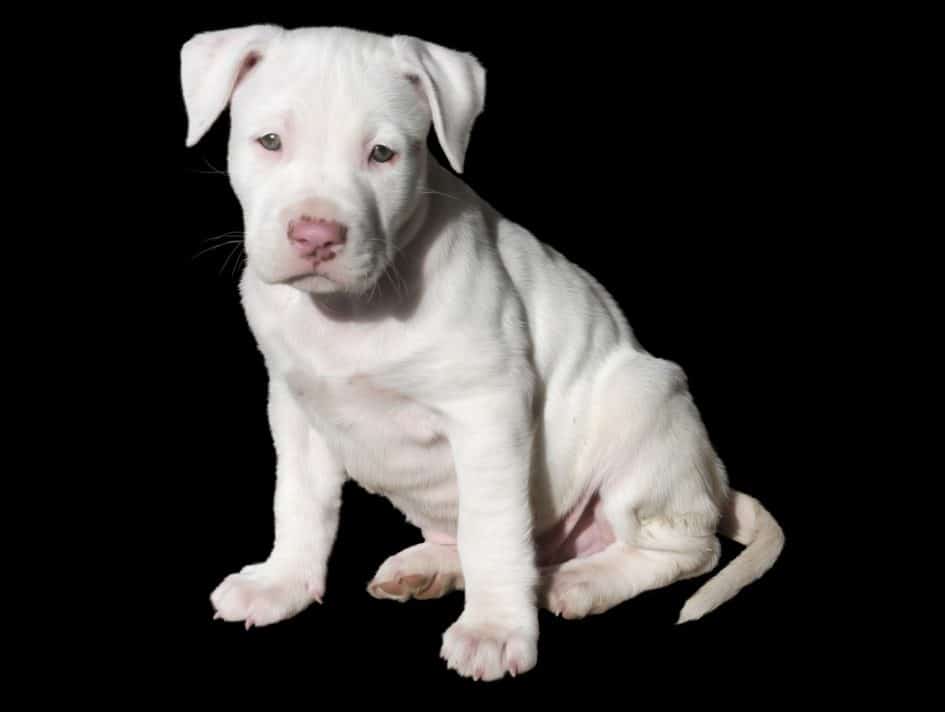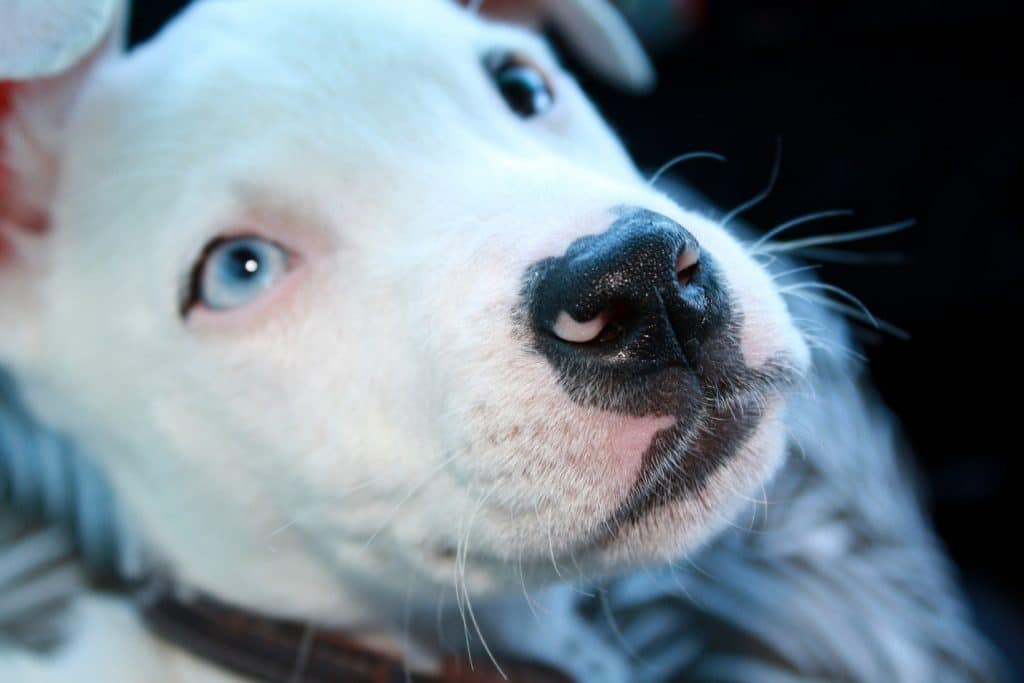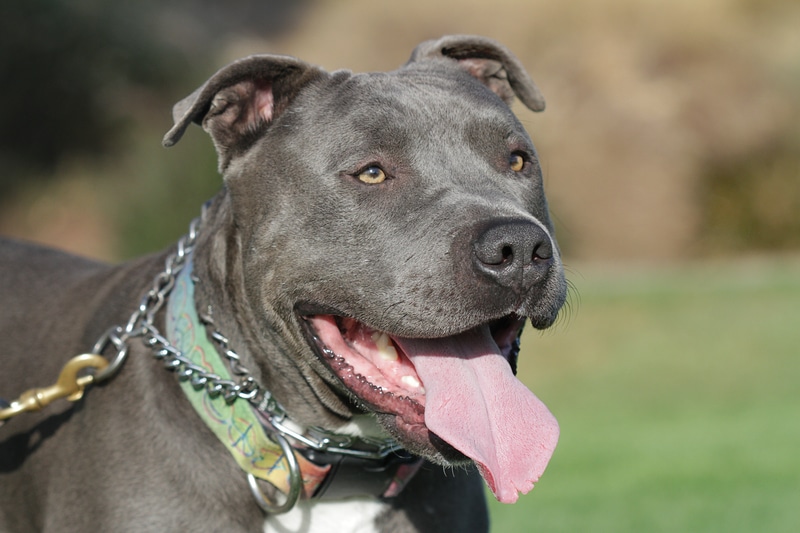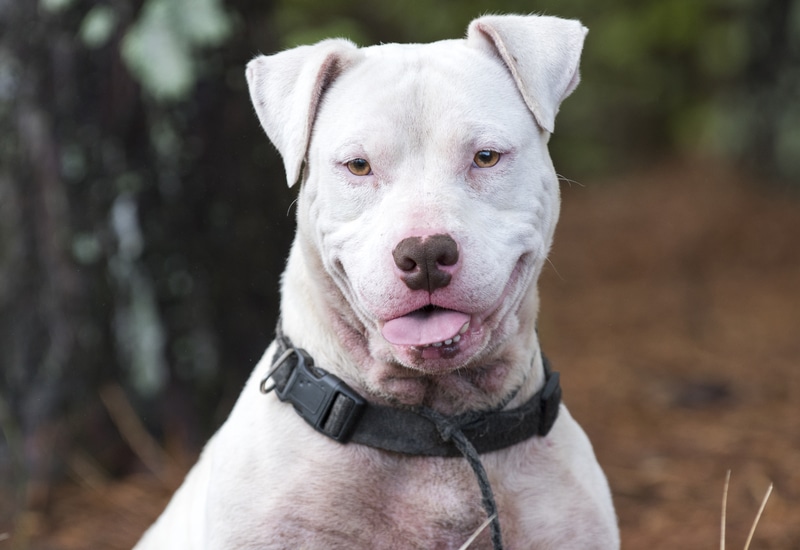

The Truth about White Pitbulls: A Complete Guide
The White Pitbull is a rather hot topic in the canine world, specifically because people believe that they are extremely rare. Read on to find out more about them.
The White Pitbull is a rather hot topic in the canine world, specifically because people believe that they are extremely rare. The truth is that while your run-off-the-mill Pitbulls with typical appearances are very common, it can be more difficult to spot a white pitbull in comparison. However, this adorable and rare color variant of the Pitbull breed most certainly deserves your attention and affection.
A White Pitbull is covered in a neat white coat, giving it a unique and eye-catching appearance, and as a descendant of bulldogs and terriers, this canine shares the intimidating build of Pitbulls. Unfortunately, dog parents prefer to steer clear of these dogs due to their tragic history of blood baiting and recognition for their aggressive personalities. However, contrary to popular belief, White Pitbulls are actually very gentle and loving.
If this breed has managed to garner your attention and pique your interest, stay tuned as we explore everything you need to know about white Pitbulls, from their appearance, history, size, weight, temperament to health problems and nutrition.
Let’s get started!
White Pitbull: What is it?
To start with the basics, as the name suggests, a White Pitbull is a variation of the pitbull breed found in a beautiful and clean white coat. Even though this breed is somewhat rare, an all-white pitbull is a standard colored coat and not a result of albinism. Unlike albino dogs, white Pitbulls have more apparent skin pigmentation. These dogs also have colored eyes.
White Pitbulls: History
“Pitbull” isn’t a breed; instead, it’s a general term used to classify the group of dogs that descend from terriers and bulldogs. Many dog breeds, including the American Staffordshire Terrier, the American Pit Bull Terrier, and the American Bully, fall under the umbrella term “Pitbull.”
In 1898, the United Kennel Club acknowledged the American Pitbull Terrier as an official and separate breed. As a result, the Pitbull we know today is actually the American Pitbull Terrier.
For years, dog fanciers have been taken an interest in Pitbulls due to their game and fighting abilities. However, now, many people also adopt these dogs as they make great and friendly companions.
The white pitbull shares the same personality as its counterparts, displaying the qualities of being a loyal companion and great warrior. What’s more is that Pitbulls are also considered as nanny dogs to their reliability and responsible behavior towards children.
White Pitbull Physical Features

When you hear the name, you know to picture a white dog but are probably wondering if White Pitbulls have any other distinct features that set them apart from other pitbulls. Truth be told, the only difference between white and typical Pitbulls is the difference in coat color. In general, all Pitbulls share the same regularities and physical features.
Here’s a deeper look at a White Pitbull’s physical characteristics:
White Pitbull Build
A White Pitbull has the same enchanting yet intimidating build and structure as any other Pitbull. White Pitbulls have a well-defined muscular structure and a pretty solid build that reflects an overall powerful athletic appearance. Its defined muscles have the right proportion, keeping them from appearing overly bulky.
White Pitbull Coat and Color
White Pitbulls have wiry coats that are smooth to touch and give off an undeniably glossy sheen. It isn’t necessary that a while pitbull be completely white. In most instances, although white is the dominating color, these pups’ coats also feature other colors, such as black or brown. The pitbull variation that features black and brown patches is known as the Moo Moo Pitbull since its fur looks like that of a cow.
White Pitbull Weight and Size
White Pitbulls are considered medium-sized canines that stand between 18 and 22 inches and weigh between 35 and 60 pounds.
White Pitbull Head
White Pitbulls have a medium-sized and proportioned head with a broad flat skull and a deep muzzle. Its ears are either set high on the head or can be rose or half pricked.
White Pitbull Eyes
These dogs have oval-shaped eyes that come in various beautiful colors, from brown to red, hazel, and black. You’ll also come across White Pitbulls with blue and multicolored eyes, but they are often considered to be due to breed defects.
White Pitbull Nose
White Pitbulls have tiny noses, ranging from red to black, blue, and chocolate. An unpigmented or Dudley nose is viewed as a defect.
White Pitbull Tail
These canines have a cute, thick, medium-length tail that is wide at the base and narrow at the tip.
How are White Pitbulls Different from Other Pitbulls?
White Pitbulls have a striking appearance like no other, and although they look different, they possess the same traits as their typical counterparts. However, besides their coat color, there are a few other factors that set them apart from other pitbulls.
Sunlight Sensitivity
Due to their pale-colored coats, White Pitbulls, specifically those with red noses, are more susceptible to sunlight. This sunlight sensitivity places them at risk of skin damage and possibly skin cancer. Hence, these dogs need to be kept indoors and walked under shades.
Price
Due to their rarity compared to their regular counterparts, White Pitbulls are more intriguing to people, and hence, have a higher demand. Considering these factors, these dogs are much more expensive than their other variations.
Genetic Makeup
White pitbulls’ genetic makeup differs from that of their regular counterparts, causing their partial loss of pigmentation. Moreover, they carry recessive traits that make them perfect for some breeding programs.
Does the Color of a White Pitbull Impact its Health and Behavior?

White Pitbull Health
The AKC Canine Health Foundation suggests that canines with white coats have a tendency to develop congenital deafness, and White Pitbulls fall in the category of those breeds.
Basically, the cells that enable pigmentation and hearing belong to the same stem cell source. The presence of unpigmented skin in the inner ear can kill off the nerve endings, and the loss of sensory hair cells inhibits nerve impulses, keeping sounds from transmitting to the brain.
This doesn’t go to say that all White Pitbulls are deaf or will become deaf, but there is a chance for them to get congenital deafness.
The link between blindness and white coats is pretty vague. There aren’t enough studies that show the absence of pigmentation in melanin causing blindness, but there are chances of them causing pale-colored irises.
White Pitbull Behavior
White Pitbulls display the same personality traits as their regular counterparts. These canines are not more aggressive than other coat colors. In fact, they are pretty adorable and loving dogs.
White Pitbull Temperament
The tragic history of bloody fighting has placed all Pitbulls under a negative light, making people perceive them as blood-thirsty or vicious. However, this isn’t true for the present.

According to a study by the American Temperament Test Society, 86.4% of Pit Bulls tested had a good temperament. This places pit bulls above 121 other dog breeds, including Golden Retrievers.
Contrary to popular opinion, aggression is a highly uncharacteristic trait of the breed. White Pitbulls are actually softies at heart and are social animals that are loyal and friendly. They love spending time with their human family and can easily mingle with other people. In fact, they are known for being better nanny dogs than guard dogs. Also, White Pitbulls can be needy, so you’ll need to shower them with attention.
Besides the snuggles and cuddles, these dogs are agile and very intelligent. Therefore, they need sports and other moderate physical activities to practice their strength.
In the case of other house pets, White Pitbulls usually keep their peace, but their instincts can fire up if they are triggered. After all, they can’t back down when challenged.
White Pitbull Health Issues
Besides the health risks mentioned above, White Pitbulls are overall healthy dogs that can live up to 12 to 14 years. However, like other dog breeds, they can develop certain health problems.
Some health implications to watch out for are:
White Pitbull Skin Conditions and Sunlight Sensitivity
White Pitbulls are prone to skin allergies and sunlight sensitivity due to their color. Most of their skin allergies are triggered by food sensitivity, which can be controlled by maintaining a hypoallergenic diet.
White Pitbull Cataracts
Pitbulls have a 50/50 chance of developing or inheriting cataracts, leading to impaired vision and eventually total blindness. This eye condition can be corrected treatments or surgery depending on its stage.
White Pitbull Hip Dysplasia
Hip dysplasia is a common skeletal condition prevalent among dogs that causes joint pain, prolonged limping, and arthritis. The best way to prevent your White Pitbull from suffering from this condition is by managing their weight and giving them joint supplements.

Wrapping Up
The reputation of White Pitbulls has been tainted due to their history and common misconceptions, but the truth is that these dogs have really fun, loving, and caring personalities. Although they may appear tough due to their strong build, they are actually huge teddy bears beneath that make for great pets. Unfortunately, these dogs can potentially develop health issues over time. But just like with any other dog, you should be willing to take the responsibility of showering them with love, attention, and affection.
Discover how to create a joyful, healthy home for your pet.
Subscribe to your weekly rundown of practice, real life ideas and training tips straight to your inbox.


